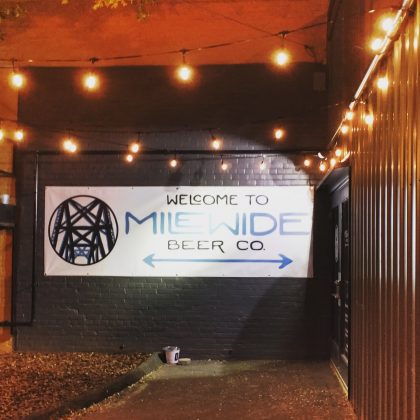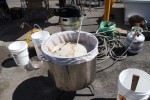 There was a great deal to learn on my most recent foray across the pond. At the risk of turning this column temporarily into a travel blog, I wanted to reflect on a few of the things I learned while attending Indy Man Beer Con in Manchester, England and brewing with Northern Monk in Leeds. Let’s call it a compare/contrast on beer culture and the possible underlying influences thereon. This data is based almost entirely on my own personal observation (largely while intoxicated to some degree) and is not supported by a great deal of in-depth research, so please forgive any inaccuracies statistical, factual, or otherwise.
There was a great deal to learn on my most recent foray across the pond. At the risk of turning this column temporarily into a travel blog, I wanted to reflect on a few of the things I learned while attending Indy Man Beer Con in Manchester, England and brewing with Northern Monk in Leeds. Let’s call it a compare/contrast on beer culture and the possible underlying influences thereon. This data is based almost entirely on my own personal observation (largely while intoxicated to some degree) and is not supported by a great deal of in-depth research, so please forgive any inaccuracies statistical, factual, or otherwise.
The first, and perhaps least genuinely impactful, thing I noticed was a substantial difference in the definition of “session” as it relates to beer strength. At AtG, for instance, we keep a beer at or under 5.0% ABV in our “Session” slot. For serious beer people in this market, this is about right. Not so in the British market. It appears that a 5.0% beer is regarded as edging toward large. “Session” beers over there are generally those in the 2.8-3.5% range. Low alcohol pub ales seem to be much more prevalent. This is probably a good thing as nearly the entire population of the country can be found down at the local and on weekends enjoying a couple pints. Our 7-8% beers were regarded as pretty damned big, and Bo&Luke was downright unsettling for many Brits.
Another pointed difference in the actual liquid was a much larger focus on cask ales. Nearly half of the beer at most pubs was cask, and many beers were available either on cask or on keg. These softer carbonated, cask conditioned beverages may be the root of the thankfully declining popular misconception that British people drink their beer warm. The mass consumption of this style of beer, which is often referred to as “real ale”, has a long history in Britain and has remained relevant in the modern day thanks in no small part to the efforts of the Campaign for Real Ale (CAMRA). While sometimes thought of as an old man’s club by younger beer folks, these grizzled individuals have made sure that “craft” and “tradition” need not be completely at odds. In the US, cask is essentially a novelty in most places. Perhaps it need not be, but the brewers and the drinkers would have to embrace it simultaneously for it to gain much traction.
Moving beyond the actual liquid in the glass, there are some differences that particularly caught my attention as a brewer. One such difference was that everyone appears to be a brewer. Nearly every pub I went to the bartender introduced him/herself and then told me what brewery they brewed for. It stunned me at first. Apparently there are about 1,285 breweries in the UK. That may not seem like a lot compared to the approximately 3,000 in the US, but the per capita difference is stunning. The United Kingdom has one brewery for just under 50,000 people. The US has one for just over 105,000 people. That’s more than twice the breweries per capita! Part of the reason I didn’t recognize most of the breweries at the taps was that they don’t distribute beer to America, but another reason was that there are just so damn many of them. Why is that?
Perhaps the massive number of breweries per capita can be explained by the ease of opening a brewery. In the US, I can’t count the number of times that a homebrewer has told me they are going to open a brewery. Once they actually dig into the reality of it, though, most of them change their mind. It is hard to overstate just how many hoops one must jump through to open and maintain an operational brewery in the US. Without getting into the respective benefits and drawbacks of heavy regulation and oversight in this industry, suffice it to say that the UK makes opening a brewery much easier. My conversation with one British brewer revealed what licensure and permits are necessary to brew beer and sell it to pubs: none. That’s right. None. If you make homebrew in your garage and want to take it down to the local pub to have it put on draft, you can. They can buy it from you and sell it to people. The only necessary license is if you want to sell it by the drink at your own place you need a £37 certificate that you have attended an alcohol safety course. Blew. My. Damn. Mind.
One caveat to this is that, with such a low bar for entry, you don’t have to be terribly committed to make it to market. The primary control on your sales is the actual quality of your product. In the US, many breweries operate under the notion that, since it is so damned hard to get going, you better make something worth drinking. Incentive.
The last difference that fascinated me was the complete lack of a three tier system. Without getting into a diatribe about three-tiers, suffice it to say that their society was not thrown into Mad Max-style disarray. Any brewer, pub, bottleshop, distributor, or importer can sell to any other brewer, pub, bottleshop, distributor, or importer. Even partial kegs seem to be ok. Brewers will sell beer back and forth between each other to keep a steady flow of guest taps on. Most brewers not only distribute their own beers in the local area but will also distribute the beers of brewers they get along with from a few towns over. Distributors succeed when they provide a service and infrastructure that brewers and retailers find valuable. The downside for us in the US is that moving beer around the UK is so easy that most of these brewers have absolutely no interest in taking their product to America. It just doesn’t make any sense. They get top-dollar (erm… pound) and very little hassle to take beer all over the British market rather than having to mark product down so that it still gets to consumers at a reasonable price after the chain of middlemen. Makes sense but also makes for fewer authentic British beers here.
Well, that’s all I have for now. I hope that was jolly illuminating. Cheerio! Until next time, faithful readers, thanks for reading, and happy drinks!
P.S. Remember to let me know if you have some specific topic you would like me to babble about next time. You can tell me in person, by e-mail, or in the comments right down below.





